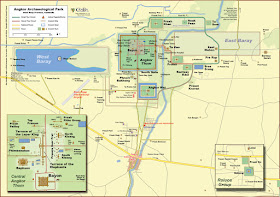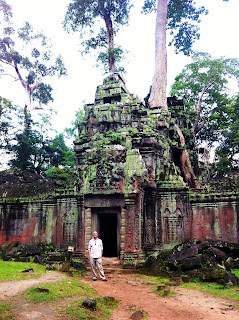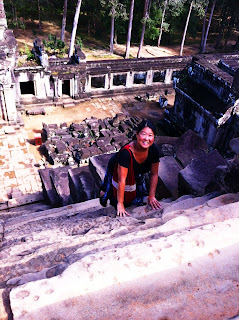Some say it is more impressive and mysterious than Machu Picchu in Peru. Having had the privilege of visiting both, Angkor is certainly more vast with Angkor Wat being the largest religious complex in the world. It covers 400 square kilometers and was the center of the Khmer Empire for 600 years from 9th to 12th century while sustaining a population of over 100,000 Khmer inhabitants. Both are mysterious and awe-inspiring. Both, a testament to what was once advanced civilizations. Khmers in Indochina. Incas in South America.
Visiting Angkor Archeological Park has definitely been a must-do/must-see on our bucket list. For purposes of this blog, there's a lot of information on the internet and in books about the history, architecture, and explanation of the details of the temples. Therefore, there really is no need to reiterate what's already out there. For a brief overview, Angkor Archeological Park -WikiTravel site is quite explanatory.
The recurring theme is that depending on which Khmer King built the temple, the temples were either dedicated to the Hindu deities of Shiva or Vishnu before the mid-12th century, while temples built by King Jayavarman VII - who converted to Buddhism - were dedicated to Buddha from mid-12th century on. Although, we found carvings dedicated to both Hinduism and Buddhism in many of the temples as religious preferences waxed and waned amongst subsequent Kings after Jayavarman VII.
For anyone trying to organize how they should "tackle" the enormous park and dozens of temples, may we suggest an itinerary that doesn't leave you completely exhausted and immobilized after the first day?
First, hire a tuk tuk driver for the day. The going rate is USD$13-16/day, which is well worth the cost, considering the distance between each of the temples, the heat, humidity, and potential for downpour rains. Our tuk tuk driver, Mr. Sa Rouen, was arranged through our hotel and he had plenty of ice cold water and wet wipes supplied throughout the day! One could rent a bicycle for very cheap, but expect a 15-30 minute cycle time between each temple, followed by lots of walking and climbing around the ruins in the heat, all day long.
The standard itinerary seems to include temples around the Small Circuit on Day 1, and temples around the Grand Circuit on Day 2 plus possibly a trek to Phnom Bakheng up on the mountain to catch a panoramic view of Angkor Wat and the Tonle Sap Lake during sunset (a featured place in the movie, Tomb Raider, as well as Angkor Wat, itself). A popular activity is to be present at Angkor Wat for the sunrise. To do this, the Small Circuit tour can be started early at 5 am, since Angkor Wat is usually the first stop; or, go back just for the sunrise on another day. The tuk tuk driver may charge extra for the early start time. We didn't do the sunrise thing. We slept in for a normal start time of 8:30 am every day.
Second, the following tips may help with a more pleasant experience:
Without spending a lot of time at each temple, the above 6 temples took approximately 7 hours to view, including time for lunch.
- Smile! The ticket office takes a digital photo of you that is part of the ticket for the remainder of your time in the park. You can purchase a $20 1-day pass, $40 3-day pass, or a 7-day pass. We bought the 3-day pass.
- Dress appropriately. Some of the ruins are still functioning temples. That means no shorts, short skirts, or tank tops. They don't provide loaner sarongs or scarfs so be prepared.
- Mosquito repellant. Although much of the vegetation around the temples have been cleared, you're still in the jungle. Those jungle mosquitos love fresh tourist blood. Reapply repellant often, especially since you'll be sweating it off in no time.
- Sunscreen, hat, and towel to wipe sweat off. Let's just say it was really, really hot and humid in the beginning of November. We can't imagine what it must be like during the summer months.
- Umbrella. When it rains it pours, especially in the afternoons. Forget trying to wait out the rain amongst the temple ruins. Most of them don't have intact ceilings or roofs. Plastic ponchos = steamy sauna, are also not ideal. Or, just plan on getting drenched. Your choice.
- The park restrooms are western style and well-maintained. Use is free for ticket holders.
- There are also plenty of restaurants throughout the park. The price seemed expensive for Khmer food at $4-6/dish, but it's a national park. What do you expect?
- At every temple entrance, you will be accosted by kids trying to sell you something. Don't get annoyed by their persistence. Instead, be amazed because they are business saavy and shrewd, not to mention their command of the English language. Sadly, school is not compulsory in Cambodia, but they are very street smart. If you have a need for a fan, bamboo flute, bracelets, 10 postcard packs, guide books, scarves, whatever, then it's usually $1 - a day's wage for the average Cambodian.
All-in-all, we visited 16 temples in 2-days. Here's how we did it.
SMALL CIRCUIT (COUNTER-CLOCKWISE DIRECTION)
- The Draw: most famous, iconic, grandest temple of all. It is a must see.
- Crowd Factor: very, very high. Extremely crowded.
- Accessibility: medium. Very large area to walk. Mostly flat paved walkways, but long. Some stair climbing. Steps to top of tower is very steep.
- Time Spent: 1.5 hours without pausing long in any area. Could easily spend 3 hours.
- Built: 12th century by King Suryavaman II, dedicated to Vishnu.
- Highlights: 5 towers representing lotus buds called quincunx; sunrise; gallery of bas-reliefs etched into stone; apsaras (celestial dancers) carvings; view from tower.
- The Draw: Small temple with 5 sanctuaries. The main sanctuary interior has large bas-relief of Vishnu and Lakshmi. This type of sculptured artwork is rare in Khmer monuments.
- Crowd Factor: Low. We had the place to ourselves.
- Accessibility: Easy. Temple is right by the Small Circuit road with very little walking or stairs.
- Time Spent: 15 minutes.
- Built: 10th century, dedicated to Hindu god Vishnu.
- The Draw: Large baray (reservoir). Royal bathing pool for ritual bathing.
- Crowd Factor: Low.
- Accessibility: Easy.
- Time Spent: 10 minutes.
- Built: 10th century by Buddhist minister of Rajendravarman II.
- Highlights: Popular spot for watching the sunrise over the waters; watch the kids playing and diving into the water
- The Draw: Buddhist temple in the style of Bayon architecture on a smaller scale (than the Bayon in Angkor Thom), with mossy stone ruins and leaning pillars of various colors and textures from natural growth and mold.
- Crowd Factor: Medium. The further we explored, the less people. We easily sat in silence amidst beautiful ruins, undisturbed and meandered through the maze of hallways without a single soul in sight.
- Accessibility: Medium. The complex itself is flat but quite large. There are lots of stones and ruins to step over, many very unstable and slippery.
- Time Spent: 1 hour.
- Built: 12th-13th century during reign of King Jayavarman VII, "The Great Builder".
- Highlights: Similar sculptures of the faces found at the more famous Bayon Temple, but without the crowd.
- The Draw: The large bayan tree roots strangling the temple ruins.
- Crowd Factor: High. Very popular and crowded.
- Accessibility: Easy. Wooden walkways with stairs built to form an intended tourist path to prevent further deterioration.
- Time Spent: 1.5 hours.
- Built: Buddhist temple built in 12th-13th century by King Jayavarman VII, dedicated to the mother of the King.
- Highlights: Nature versus Man - nature is winning.
- The Draw: Panoramic view from the top terrace of the tower.
- Crowd Factor: Low.
- Accessibility: Difficult. There's at least 50 very large, steep, and uneven stone steps to climb in order to reach the upper terrace.
- Time Spent: 30 minutes.
- Built: First temple to be built entirely of sandstone for Jayavarman V.
Without spending a lot of time at each temple, the above 6 temples took approximately 7 hours to view, including time for lunch.
Typically, a tour of the large Angkor Thom complex concludes the Small Circuit itinerary. This would've taken another 3 to 4 hours to complete, so we decided to postpone Angkor Thom to Day 2.
Continue on to Day 2 itinerary.








































